The Best Standing Rib Roast – Ever! Keto Magic (We Cain’t Make This Stuff Up | No Fail)
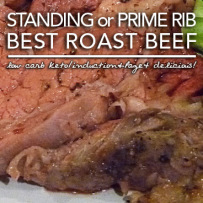
Are you intimidated by big hunks of meat-tacular beef? Do you yearn for the secret to making succulent standing rib, sometimes called “prime” rib, at home, but don’t want to risk failing and ruining an expensive piece of beef? Fluffy Chix Cook has you covered with their TNT (tried n true), never fail recipe for Christmas “roast beast,” no stress, angst, crying or failure involved. Join the Fluffys for perfect standing rib roast every time and understand why this really is, “the best” standing rib roast you’ll ever make.
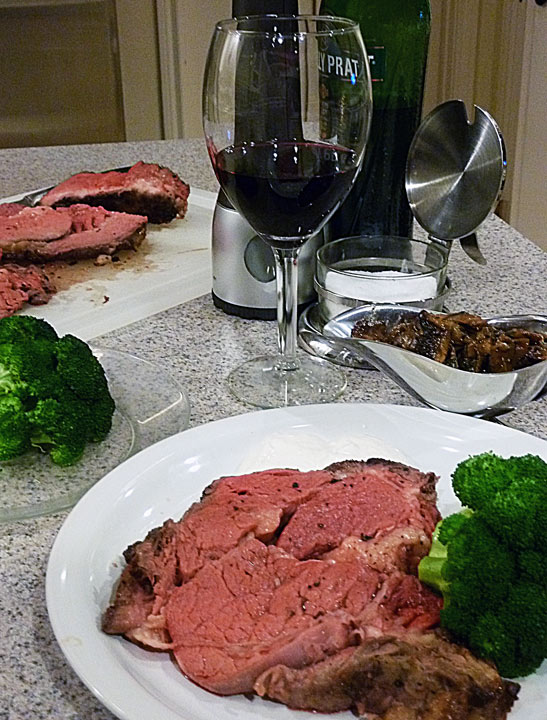
Many people get their panties in a twist when looking at a big hunk of meat. Anxiety washes over and you doubt your cooking chops. Do you have the hutzpah to pull off perfectly roasting a big cut, possibly an expensive cut, of beef or “fill in the name of your favorite animal?” Relax, relax, deep breaths and take the load off, Sally. This will be an exhaustive and long post.
We first published our Prime Rib post in the Fluffy Chix Cook Recipe Archives, but it has such useful information we decided to move it and update it a little bit. We promise it is well-worth reading. And we’ll follow this traditional method of cooking with our updated version using the Char-Broil The Big Easy Oil-less Turkey Fryer. Impossibly, it produces even BETTER standing rib roast than the traditional method. But regardless of the method you choose, let’s get one thing straight right now. You will (MUST) need to have a meat thermometer that inserts and is left in the thickest portion of the roast. It remains inserted throughout the cooking process and will only be removed after the standing rib is roasted and rested, ready to cut.
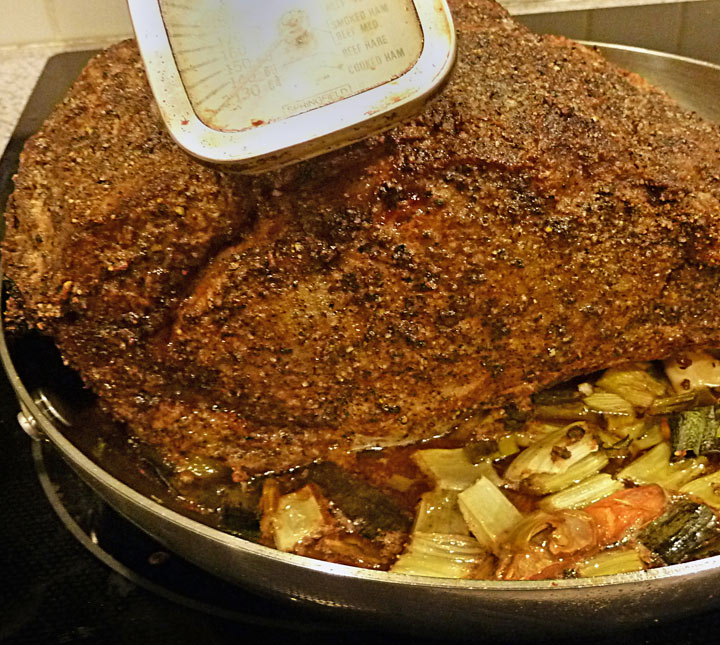
Fluffy Chix Cook began the tradition of serving a standing rib or prime rib roast and eating our “big” fancy meal on Christmas Eve back in the 80’s. We’re not sure how this big meal evolved to include the standing rib, sometimes called prime rib, but I suspect it had something to do with the fact that Dad had become ill and had ceased hunting, which meant we no longer had fresh venison or wild goose and ducks at the ready. He also no longer had the stamina to stand in the kitchen for up to two days cooking his infamous Pat O’ Brien Spaghetti and Meatballs or making his delectable Shrimp Creole. So we had the changing of the kitchen guard, and with that change, the new guard decided it would be fitting to return to our Anglo-Saxon roots. The prince of English dinners (at least to our family) is standing rib, or prime rib, Yorkshire pudding (super high carb), and all the trimmings. Over the coming weeks leading to Christmas, we will explore the quintessential low carb keto Christmas meal, complete with standing rib, horseradish sauce, and low carb keto Yorkshire pudding.
Part of the credit for the Fluffy traditional standing rib roast Christmas Eve dinner must go to Dr. Seuss and the Grinch Who Stole Christmas. We always imagined that our standing rib greatly resembled the Whoville Roast Beast and it tickled us to join hands round the table to sing Da-Who Doré, Welcome Christmas. So we lobbied for the standing rib roast as a replacement player on the family table early in life.
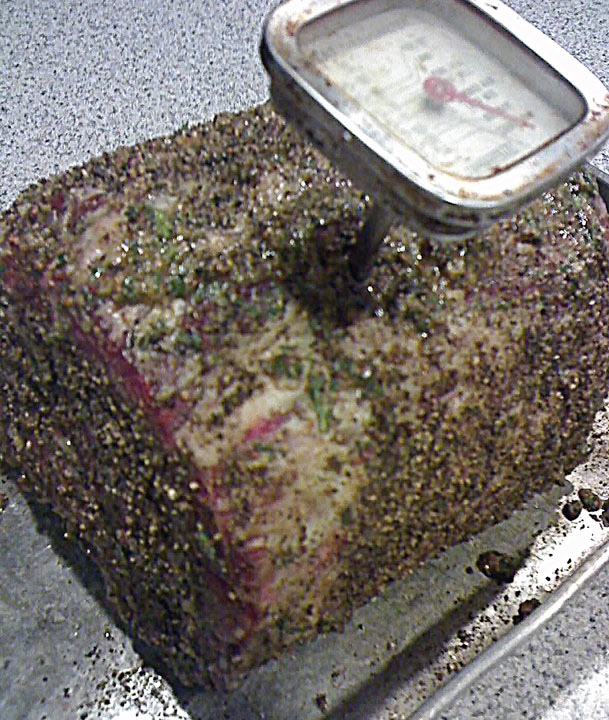
It’s quite nice that the rest of the country decided to become attuned to the Fluffy family Standing Rib Christmas Eve dinner tradition too. Look, we cain’t make this stuff up. We invented it and the rest of the country followed suit. Because that means, standing rib conveniently goes on sale the week before Christmas–every year. Score! We remember buying it for $2.99/lb. Seems crazy cheap in retrospect! But then as little as last year, we found it on sale routinely for $3.98/lb. This year it is $4.98/lb and we have the sinking feeling this may be the last year standing rib roast will hit within our Christmas dinner budget.
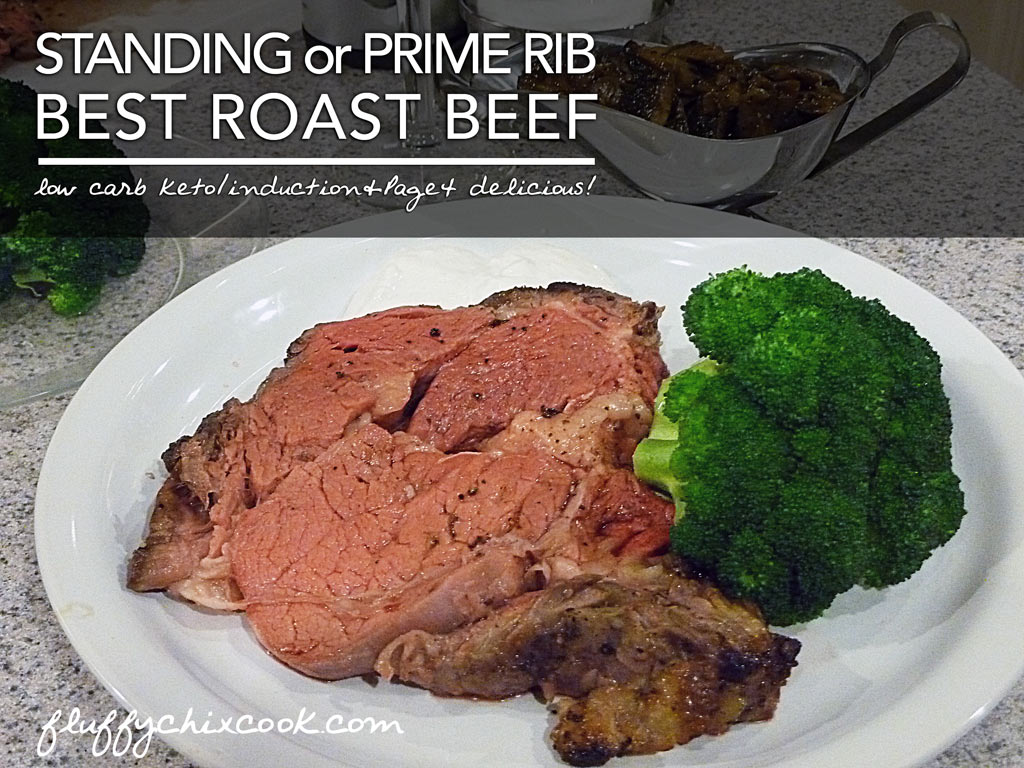
Needless to say when it goes on sale, we buy as much as our pocket book allows. Have the butcher cut it into large 1-bone and 2-bone roasts and have an intimate date in the kitchen with the Food Saver. We’ve actually stored rib roasts for over a year in a vacuum sealed bag without an inedible loss in quality. Now before we get a lot of hate male, let us explain…there is a WORLD of difference between fresh, never frozen meat and frozen meat. We don’t care how great a vacuum sealer you use, freezing meat alters its integrity and flavor. Fat picks up “off” flavors from your freezer and icebox very easily – even when vacuum sealed. And ice crystals pierce cell walls and cause a moisture loss once thawed.

But if you are a budget, sale, shopper as we – due to economy – freezing is the only option in our opinion. And compromises can be made with very lovely results. We should also admit we didn’t intentionally keep a standing rib roast in Deep Space Nine (the chest freezer). It was an accident. We kinda sorta lost it at the bottom. *blush* Our bad. We were very timid when we cooked that gorgeous hunk of year old roast beast, but to our surprise, it tasted delicious!
STANDING RIB VS PRIME RIB
Also let’s explain Prime Rib versus Standing Rib. Prime rib is a description of roast that precedes USDA grades, meaning the “best part of the beef rib”. But in recent history, we have begun to expect “prime rib” to actually embrace the USDA prime grade. The difference in cost between prime and select (which is the grade found in most super markets) is about $25.00/lb. We sometimes see actual “prime” rib on sale for around $15.99 – $21.99/lb. But as we mentioned above, we saw $4.98/lb for standing ribs, also called bone-in ribeye roasts during the past year and suspect most of those are select or choice at best.
The United States Department of Agriculture or USDA for short, grades meat in this order: Select, Choice and Prime with select being the lowest and prime being the best. It’s based on meat quality and the amount of internal marbling. The more internal marbling a piece of beef has, the longer the beef has been at the finisher and the more tender and flavorful the meat.
Until a few years ago, most true “prime” meat went to stock the kitchens of restaurants and hotels. A store might claim the meat was a prime rib per the traditional nomenclature for that type of rib roast when truly, it was perhaps, a choice grade at best. Now days, we have premium grocery stores with butcher counters and can buy actual “prime grade beef” in several of the most popular cuts of beef, including the standing rib or prime rib. Confusing, huh? But, we Americans tend to short hand the term prime rib to mean any ribeye of beef cooked as a rib roast or standing rib. You see, we use The “Coke” Rule for this type of vocabulary free-wheeling.
ABOUT THE COKE RULE
HOW TO PICK OUT A PRIME RIB OR STANDING RIB ROAST
Rule #1 – Look for the cap or the lip.
Photo courtesy of No Eyed Doe. They have an awesome explanation of ribeye musculature.
The cap or lip, known as the spinalis dorsi muscle is the muscle that sits on top of the central clot of meat called the longissimus dorsi. It represents the biggest portion of the meat at the front end of the ribeye primal (towards the chuck end) – also called the large end. (Thanks to the folks at No Eyed Doe for the use of their photo showing the ribeye musculature.)
The large end is often referred to as the second cut (sometimes the third cut if you’re referring to rib #6 and 7). The “first cut” refers to the small end, also called the loin end. But the small end actually has the smallest spinalis dorsi muscle and the biggest longissimus dorsi. Confused yet?
J. Kenji Lopez at Serious Eats has the most amazing description and explanations about a prime or standing rib you could possibly want. We recommend you spend some time over at his site. He will explain it much more in depth. Kenji also has a great overview of the top 4 cuts of beef steaks.
The spinalis dorsi muscle or ribeye cap or lip is without doubt, one of the most tender and flavorful cut of beef on the planet. In fact when dining out, we will order the biggest cut of prime rib from a steak house knowing we won’t possibly finish it. We’ll ask to choose the cut individually and the manager will show us the steak…and we will look for the cap. If it is well-marbled with a prominent cap…oh man, we’re there. Now, please don’t overcook it! Then we will only eat the cap portion or maybe even just a portion of the cap and bring the rest home for Lucky Leftovers – usually enjoyed as steak and eggs the next morning.
Rule #2 – Look for marbling.
As I said in Rule #1, Kenji has a super explanation of the grades of rib roasts. You should spend time there getting to know the cut. But rule of thumb is: the more marbling a piece of beef has, the higher the grade. That’s not to say you can’t luck out and find well-marbled cuts of select or choice beef. Cuz I do it regularly. That’s how my sweet daddy taught us to choose meat.
But even the most well-marbled cut of choice standing rib roast will never compare to true prime grade beef. But that dog will still hunt! (Meaning if you have champagne tastes on a beer budget as I do…well-marbled select or choice is where it’s at. That beef will still taste A-Mazing!) But good Lordy, don’t get me started on the whole grass fed versus CAFO versus, organic grass fed prime aged Angus! *stars*
Rule #3 – Choose the right amount of meat for your use.
From Susie’s old food service and restaurant days, the jump off in counting how much beef per person? Estimate 2 people per rib. You will typically still enjoy leftovers. That’s about 8-10 ounces raw per person.
We get 4-6 meals out of a thick cut, single bone roast because Susie eats the rib and meat on the rib for her first meal and a little bit of the tail meat (longissimus costarum), then we cut 3-5, ½” portions of rib roast with the remainder. A 2-bone rib will serve anywhere from 4-6 people, depending on your sides and on their appetite. We’ll warn you right now, guys will want seconds and so will a lot of women!
Rule #4 – NEVER, and We do mean NEVER ever let the butcher cut the bones off your roast!
We don’t care if they do retie them! Don’t do it. The bones help you control your temperature better and result in a more tender and flavorful experience. If they cut the bones off and retie, you will still lose too much moisture from the meat and you’ll end up with a tougher, drier roast. It’s easy to make a cut down the ribs to remove the ribs once you’ve cooked the meat and rested it.
HOW TO COOK A PRIME RIB OR STANDING RIB ROAST
Rule #1 – ALWAYS, and We do mean ALWAYS use a thermometer to cook your meat.
Period. The end. Use the kind that stays in while the meat cooks. Make sure it’s accurate. Remove the meat anywhere between 125°-128° for rare to medium-rare.
Rule #2 – Now let’s talk about the seasonings for a Standing Rib or Prime Rib.
We generally season rib roasts the day before cooking and yes, we liberally salt the meat. We do this because salt, in the short term, draws moisture out of the meat, but salt over a long time actually draws moisture back into the meat and at the same time carries along with it, other agents of flavor such as herbs and spices (think about brining or dry rubbing meats) – the salt carries the moisture and flavors back into the meat in both of these applications.
You can get fancy. Sure, herb crust the standing rib if you want! We’ve used the following combinations with excellent success:
- Fresh garlic, rosemary, ginger, kosher salt, cracked black pepper, and olive oil.
- Fresh garlic, rosemary, sage, kosher salt, cracked black pepper, and olive oil.
- Fresh garlic, rosemary, thyme, Italian parsley, kosher salt, cracked black pepper, and olive oil.
- Granulated garlic, dried rosemary, dried thyme, dried parsley, kosher salt, black pepper, and olive oil.
- And our old standby–Dad’s Basic: Fresh garlic, kosher salt, cracked black pepper, Worcestershire Sauce, and olive oil.
Rule #3 – To brown or not to brown, that is the question!
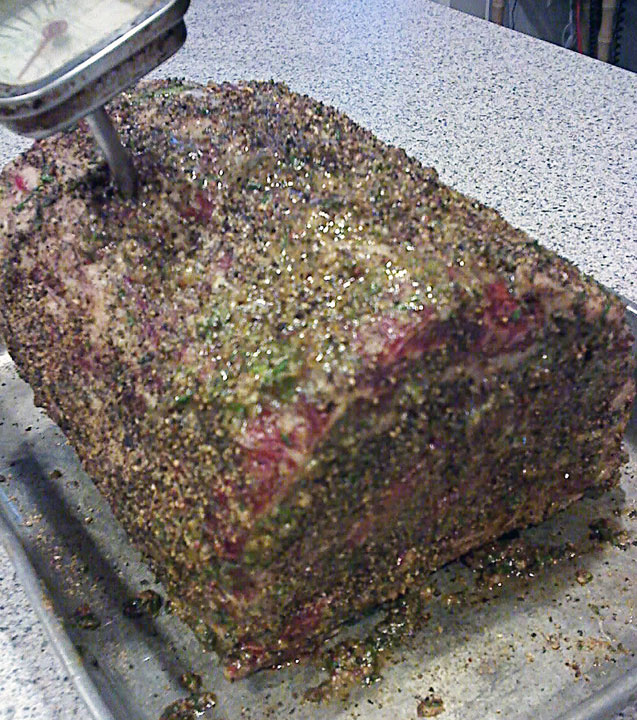
We have used the technique of salting and browning the meat in olive oil or bacon grease prior to seasoning the meat, as well as, seasoning the meat in its entirety and THEN browning the meat in olive oil or bacon grease.
The idea about browning it with only salt first, comes in because it’s easy to burn herbs and spices when browning the meat and it’s also easy to lose most of the seasoning crust while browning the meat. We also sometimes think the seasonings interfere with the browning because the spices keep the meat from experiencing the true Maillard effect. The herbs and spices form a barrier, preventing the meat from reaching the entire surface of the browning pan and heat source.
Single bone prime rib.
Our rule of thumb is: The larger the cut of meat, the more freedom of choice between seasoning before browning or after browning. In a small single bone rib roast, we will season first. In a large standing rib, whether we season before browning, or not, depends on our energy level and how much hassle we’re willing to go through!
If we’re cooking a full rib roast, which is large and difficult to maneuver, we will forgo browning the roast and will instead use the JOY OF COOKING method for cooking prime ribs. Start the roast at a high temp(500*) for the first 15 minutes of roasting, then drop the temperature to roast it at 325° until the internal temperature in the largest portion of the meat comes up to serving temp. Again, see Kenji’s blog for an awesome temperature chart.

We do like browning the exterior meat prior to roasting, because it gives a much heavier crust outside, especially when cooking a smaller roast – while still allowing a rare to medium rare center. Many people will disagree about browning first rather than browning last. We think the trick is to not over-brown. We also believe in removing the meat from the fridge and going directly to the fire. That gives us a bit of “play” because the center of the meat is ice cold and it prevents over-cooking. We never experience the grey ring around the exterior of the meat. This grey ring is often used as a reason for cooking low and slow then finishing with a sear at the end. We have however experienced the grey ring when trying to sear it at the end.
Whichever method we use to brown the meat, as mentioned in Rule #1 of How to Cook a Prime Rib, ALWAYS use a meat thermometer and cook the roast to temperature. We use 15-20 minutes per pound as very basic guideline to get us to the ball park. We never cook an expensive roast by time. Too much can go wrong and every thermometer is different! We use Dad’s old thermometer and by that thermometer, we know our standing rib roast is perfect EVERY time when we take it out when the thermometer reaches between 125-128° at the thickest portion. There will be holdover cooking and temperature will continue to rise once removed from the oven another 5-10 degrees. The smaller roasts get taken out at 125° on the dot.
Rule #4 – The rule the precedes all other rules of How to Cook a Prime Rib
Rest the roast for 10-15 minutes.
Thou Shalt ALWAYS rest the meat after cooking! Yes, the main secret to beautiful roast beast is to ALWAYS remove the roasted beef from the hot pan and allow it to rest for 10-15 minutes prior to cutting it. Don’t pierce it with a fork at any time during the cooking or resting process. Don’t remover the meat thermometer. Keep it in while it rests to keep the hole plugged and to keep juices from escaping. Resting the meat allows the juices to recirculate back into the center of the meat. The result is a beautifully uniform pinkness, as opposed to having a raw looking center and a sadly prominent grey ring around the outer edges of the meat.
Use this resting time to finish your sauce or jus (pan juices). You’ll thank yourself later at your cleverness.
So now that we’ve perhaps thoroughly confused you, or put you to sleep. Let’s get down to the recipe. It’s difficult to figure the true carb counts on this baby, because we use a mirapoix (coarsely chopped onion, celery and carrots), along with whole cloves of garlic to line the roasting pan. The veggies form a base to set the meat upon, to keep it out of the moisture at the bottom of the pan, and facilitate even browning on all sides. The veggies also season the meat drippings and also prevent the pan from smoking when rendered fat from the meat hits the hot surface of the roasting pan.
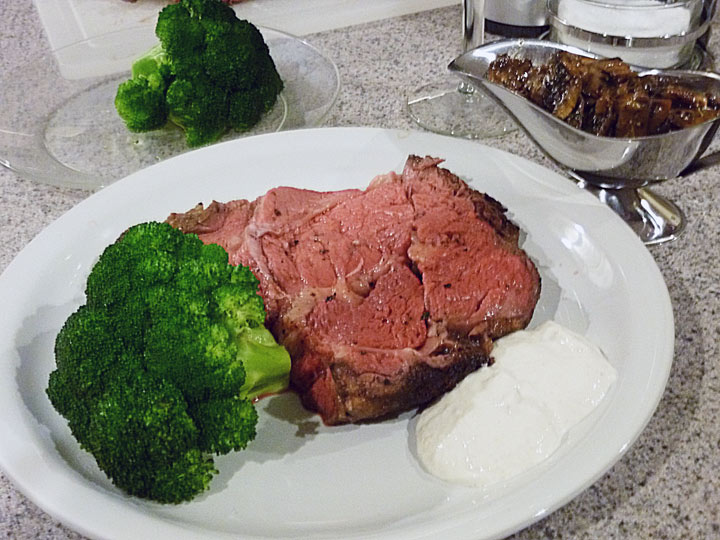
We use the mirapoix and there are certainly carbs that result from their use, but how many? How do you quantify that if you aren’t truly eating the veggies themselves? It’s a bit of a guess. We don’t think using the au jus recipe contributes more than a gram or two of carbs per serving of meat at the very most.
We hope you will try this method of cooking a standing rib or prime rib roast and promise it will be one of the most delicious experiences of your culinary existence. You will forever become one of those tiresome individuals who insist on hand picking your cut of meat at restaurants and your picture may be put up as a warning on those same restaurant walls in much the same way the Post Office exhibits most wanted posters of criminally insane fugitives.
Merry Christmas to you and yours, and Season’s Eatings!
The Best Standing Rib Roast – Ever! Keto Magic (We Cain’t Make This Stuff Up | No Fail)

Notes
This is the crème de la crème of roasts. We don't care if you call it a standing rib roast or prime rib. It's merely semantics and the pleasure experience is the same! This is not a meal where you want to even consider counting calories. We'll warn you now, the calories will scare the bejeesus outta ya! So simply resolve to enjoy and know you are feeding your cells with nutrition from the fat and great source of protein inherent in the cut.
Please serve it with horseradish sauce or if you want to guild the lily, sauce béarnaise. Oh my! Heavenly perfection on a plate! The au jus is a delicious accompaniment and is also a must have to complete the experience.
Standing rib doesn't have to cost a fortune nor does it have to be a multiple bone roast in order to enjoy it. Two people can enjoy a single bone prime rib very easily as shown in our Christmas Eve dinner. We got 2-4 meals for 2 people out of our thickly cut single bone prime rib.
To get a thick cut of a single bone roast instruct the butcher to cut up to the preceding bone on one edge and over to the following bone at the second edge. That way you have a central rib and thick portions of meat on either edge of the rib. If they love your business, they will do it for you! Instruct them to NOT cut off the bone or trim off the fat or tail! You want all of it so you can decide how much fat you want to trim. We don't trim any! And the tail is one of the most delectable parts!
Buying the most marbled cut of sale beef will result in a delicious roast for those of you who are force to observe budgets. We so wish we had the luxury of eating Pat Lafrieda's prime aged beef. It tastes like no other. So fantastically delicious.
Serving Ideas Serve prime rib with au jus, horseradish sauce or béarnaise sauce. Prime rib works great with smashed cauliflower, sautéed mushrooms, asparagus, broccoli, Brussels sprouts or almost any vegetable. It also works great with a simple salad and House Vinaigrette.
Nutritional Information
Per Serving 6 ounce: 865 Calories; 73g Fat (78.1% calories from fat); 38g Protein; 8g Carbohydrate; 1g Dietary Fiber; 177mg Cholesterol; 1254mg Sodium; 7g Effective Carbs
Copyright © 2012 Fluffy Chix Cook. All rights reserved.
Ingredients
For Prime Rib
- 2 pounds beef rib, large end, (thick cut, 1 bone roast)
- 2-4 cloves garlic, minced or pressed
- 1/3 cup Italian parsley, chopped
- 2 teaspoons kosher salt
- 1 tablespoon cracked black pepper
- 1 tablespoon Worcestershire sauce
- 1 tablespoon olive oil
For Au Jus
- 1 cup red onion, peeled and coarsely chopped
- ½ cup celery, coarsely chopped
- ½ cup carrots, coarsely chopped
- 8 cloves garlic, whole unpeeled
- ¼ cup dry vermouth
- ¼ cup beef bone broth
- 2 tablespoons butter
- Kosher salt and cracked black pepper
Instructions
- For Standing or Prime Rib
- Up to 2 days ahead, wash, dry, trim, and season rib roast. Many people tie the roast, but we don't generally tie a bone in roast with intact ribs and fat layers.
- Finely mince or press 2-3 cloves of garlic and massage into muscles of meat and along the outer edges of fat as well as the underside of the rib roast. Rub kosher salt onto meat. This will feel like you are adding a lot of salt, but you have a big cut of meat.
- Coarsely chop herbs and combine with any spices and black pepper. Crust meat with herb and pepper mixture. Don't forget the edges and underside too! Drizzle meat with Worcestershire sauce and olive oil on all sides.
- Place meat bone side down, fat side up on a large platter that will fit into your refrigerate. Seal well with multiple layers of plastic wrap. Refrigerate a minimum of 4 hours and up to 48 hours. When ready to cook, remove meat from fridge and unwrap. Heat heavy roasting pan on the stove top over medium high heat until pan is very hot. Be sure to have your fan on because there will be smoke! Add olive oil or bacon grease to pan and coat bottom of hot pan. Immediately add the rib roast, flat side down. Let it brown for about 3 minutes per side without moving it in the pan. When time is up, flip the rib roast to the second side. Begin timing again for 3 minutes.
- When time is up, flip the roast to sit on its fat edge. Hold the roast in place with long tongs. Allow it to cook on fat edge for another 3 minutes. When that final 3 minutes (9 minutes total) has finished, remove pan from heat.
- Remove meat from pan and add mirapoix and cloves of garlic into bottom of pan. Use a large, heavy skillet to brown and roast a small 2 pound standing rib roast. If you are making a larger roast, follow the same technique but use a heavy gauge roasting pan to brown and roast the standing rib. Place roast fat side up, rib side down on top of mounded veggies. Insert thermometer into the thickest portion of the roast. Place roast into 325° oven and roast to an internal temperature of 125°.
- Remove roast from oven and place on a cool platter or on a cutting board. Rest meat for 10-15 minutes. Do not cut or pierce meat at this time. Make au jus sauce while meat is resting.
- For Au Jus
- To make au jus, take roasting pan and place over high heat on the stove top. Pour in 1/4 to 1/2 cup dry vermouth or dry red wine. Scrape bottom of pan with spatula to deglaze pan. Cook pan while stirring with spatula for about 3-4 minutes in order to cook alcohol slightly. Add 1/4 cup beef broth (homemade preferred). Continue to cook. Taste to adjust flavors. Is it too concentrated and salty? Add 1/4 cup of water and re-taste. If necessary, add more broth or water in order to bring the taste to your preference.
- Remove and reserve cloves of garlic in their peels. Strain sauce through a mesh strainer. Push veggies against the bottom of the strainer to extract as much fluid as possible into the sauce. The bottom of the roasting pan should be clean as a whistle at this point! Discard veggies and retain jus. Evaluate the jus. Does it have too much fat layered on the top of the juices? If so, spoon off the top layers of fat. But save this! It's liquid gold and delicious as a fat to sauté veggies and for use in making popovers and Yorkshire Puddings.
- Pour jus back into a sauté pan. Bring to a heavy simmer and once simmering, turn off heat. Drop 2 tablespoons of ice cold butter into sauce in small slices. Shake pan to incorporate butter. The butter will actually thicken and make the sauce have more body. Place au jus into a gravy boat or into individual au jus bowls.
- To Slice
- To slice standing rib, hold rib up so the largest part of the rib sits on the cutting board. With the flat edge of the knife positioned to be as close to the rib as possible make a long, slicing cut down the rib, and following as closely to the bone as possible. Imagine following the bone with the flat surface of the knife as closely to it as you can. You will be left with a very clean bone and an intact piece of meat. One bone is removed, slice roast into 1/4 to 1/2 inch slices and serve with au jus and roasted garlic. Allow each person to squeeze the garlic out of their pods and onto the plates as a condiment for the prime rib.
Nutrition Facts
The Best Standing Rib Roast – Ever! Keto Magic (We Cain’t Make This Stuff Up | No Fail)
Serves: 4-6 servings
|
Amount Per Serving: 4-6 oz cooked
|
||
|---|---|---|
| Calories | 865 (1/4 recipe) | |
| % Daily Value* | ||
| Total Fat 70g | 107.7% | |
| Saturated Fat | 0 | |
| Trans Fat | ||
| Cholesterol | 0 | |
| Sodium | 0 | |
| Total Carbohydrate | 0 | |
| Dietary Fiber | 0 | |
| Sugars | ||
| Protein | ||
| Vitamin A | Vitamin C | |
| Calcium | Iron | |
* Percent Daily Values are based on a 2,000 calorie diet. Your daily values may be higher or lower depending on your calorie needs.
Fluffy Chix Cook
Copyright © 2014 Fluffy Chix Cook. All rights reserved.

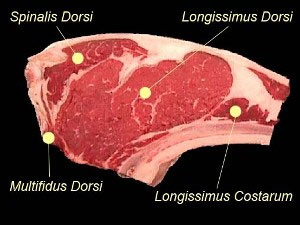
![20101210-prime-rib-primer-roast[1]](https://fluffychixcook.com/wp-content/uploads/2014/12/20101210-prime-rib-primer-roast1.jpg)




0 Comments
Trackbacks/Pingbacks